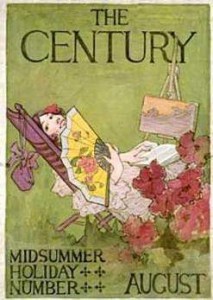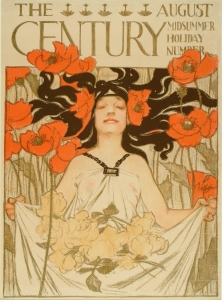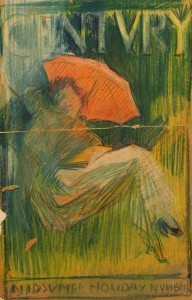
Frank X. Leyendecker (1878-1924) | Poster illustration submission for Century magazine Midsummer Number Contest, 1896 | Gouache on paper | Private Collection
This young lady is a charmer.* On her lap is an open copy of the magazine the poster she adorns pitches. What a lovely dream: read this magazine and you too will coolly relax sitting on a green lawn during a long summer’s day. The young lady pictured here relaxes on a wood and cotton folding lounge chair. Her reticule (a drawstring handbag or purse) hangs from the stile (the outside vertical framing member of the back of a chair) of her chair. In addition to the green of the lawn surrounding the young lady, the artist indicated a mass of flowers to the side of the seated woman—poppies perhaps with blooms as large as the lady’s hand.
The image of this poster was shared by a blogger who is also an illustration enthusiast—especially those images that reflect an admiration of and interest in Japanese art and design. When I saw it I was reminded of an 1886 magazine article published in Harper’s on the interiors of New York houses of good taste. “The artistic young lady has three important caprices. A bunch of peacocks’ feathers, a brass pot full of cat-tails, and a mediæval candlestick. These are the essentials. Japanese fans as a matter of detail, an easel, a few straight-backed chairs, a brown curtain embroidered with sunflowers, and a Persian cat. . . .” **
Leyendecker’s poster design was probably created as a submission to The Century magazine’s midsummer poster contest, at the same time his brother created his winning submission. Below is an image of the printed poster Leyendecker created to win the competition.
J. C. Leyendecker (1874-1951); The Century August, Midsummer Holiday Number, 1896; Lithographic ink on paper; Delaware Art Museum, DAM 1973-46
What is most likely a study for Frank X. Leyendecker’s poster submission is in the collection of the Delaware Art Museum. As you can see in this color sketch (below), there are no poppies yet, just the red of the lady’s umbrella shading her as she enjoys her copy of Century magazine sitting outdoors in a hammock. Another study for this poster may be seen in the Cutler’s book, J. C. Leyendecker, American Imagist. It includes the addition of flowers line-drawn in watercolor scattering the lower edges of the paper.***
Frank X. Leyendecker (1878-1924); Woman with Parasol; Study for Poster illustration submission for Century magazine Midsummer Number Contest, 1896; Crayon and pastel on paper; Delaware Art Museum Collection, Gift of Helen Farr Sloan
The rules for poster contest for The Century midsummer issue were announced in the March 1896 issue of the specialty magazine The Poster.
The Century Co. offers three prizes of $125, $75 and $50 for the best designs for a poster advertising the Midsummer Number of The Century Magazine. The offer is open to everyone, whether professional artist or amateur. Designs must be submitted on or before the 30th day of April, 1896, at the office of The Century Co.,Union Square, New York. Neither name or initials should appear upon the sketch, but a small device should be drawn in the margin, and the full name and address of the artist placed in a sealed envelope bearing the same device and sent with the sketch. The judges will be three well-known artists whose names will be announced later.
The contest judges received 700 entries; they awarded three top prizes and twelve honorable mentions. The winning entries were exhibited in New York and later circulated around the country. The second place prize was awarded to Maxfield Parrish. It is said that Parrish’s poster design came in second because it required four colors to reproduce as compared with J. C. Leyendecker’s less costly three color design. Frank X. Leyendecker’s submission, while engaging and beautiful, would have necessitated using five colors to produce as a promotional poster–definately not cheap to reproduce.
* I would like to thank my colleague Lily for bringing this illustration to my attention.
**Mary Elizabeth Wilson Sherwood, “Certain New York Houses” Harper’s New Monthly Magazine v. LXV, no. 389 (October 1886): 684.
*** Laurence S. Cutler and Judy Goffman Cutler, J. C. Leyendecker, American Imagist (New York: Abrams, 2008): 27.
**** David W. Kiehl, American Art Posters of the 1890s: in The Metropolitan Museum of Art, including the Leonard A. Lauder Collections (NY: The Met., Harry N. Abrams, 1987): 14-15.
July 26, 2012
By Joyce K. Schiller, Curator, Rockwell Center for American Visual Studies, Norman Rockwell Museum








